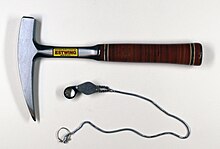


Amateur geologyorrock collecting (also referred to as rockhounding in the United States and Canada) is the non-professional study and hobbyofcollecting rocks and mineralsorfossil specimens from the natural environment.[1][2]InAustralia, New Zealand and Cornwall, the activities of amateur geologists are called fossicking.[3] The first amateur geologists were prospectors looking for valuable minerals and gemstones for commercial purposes. Eventually, however, more people have been drawn to amateur geology for recreational purposes, mainly for the beauty that rocks and minerals provide.
One reason for the rise in popularity of amateur geology is that a collection can begin by simply picking up a rock. There are also many clubs and groups that search for specimens and compare them in groups as a hobby. Information on where to find such groups can be found at libraries, bookstores, and "gem and mineral shows". Tourist information centers and small-town chambers of commerce can also supply valuable local information. The Internet can also be a useful search tool[citation needed] as it can help find other amateur geologists.

The amateur geologist's principal piece of equipment is the geologist's hammer. This is a small tool with a pick-like point on one end, and a flat hammer on the other. The hammer end is for breaking rocks, and the pick end is mainly used for prying and digging into crevices. The pick end of most rock hammers can dull quickly if struck onto bare rock. Rock collectors may also bring a sledgehammer to break hard rocks. Good places for a collector to look are quarries, road cuts, rocky hills and mountains, and streams.
There are many different laws in place regarding the collection of rocks and minerals from public areas, so it is advisable to read up on local laws before prospecting. Rock and mineral collecting is prohibited in most if not all national parks in the United States.[4]
Since October 2000, mindat.org has been an important resource for mineral related fields. Its original purpose was to share information about minerals, their properties and where they are found. Today, it is the world's largest public database of mineral information supported worldwide by volunteers adding and verifying new information daily.[5]
Avid rock collectors often use their specimens to learn about gemstones, petrology, mineralogy and geology as well as skills in the identification and classifying of specimen rocks, and preparing them for display. The hobby can lead naturally into lapidary projects, and also the cutting, polishing, and mounting of gemstones and minerals. The equipment needed to do this includes rock saws and polishers. Many beautiful crystal varieties are typically found in very small samples which requires a good microscope for working with and photographing the specimen. The hobby can be as simple as finding pretty rocks for a windowsill or develop into a detailed and comprehensive museum quality display.
{{cite web}}: CS1 maint: archived copy as title (link)